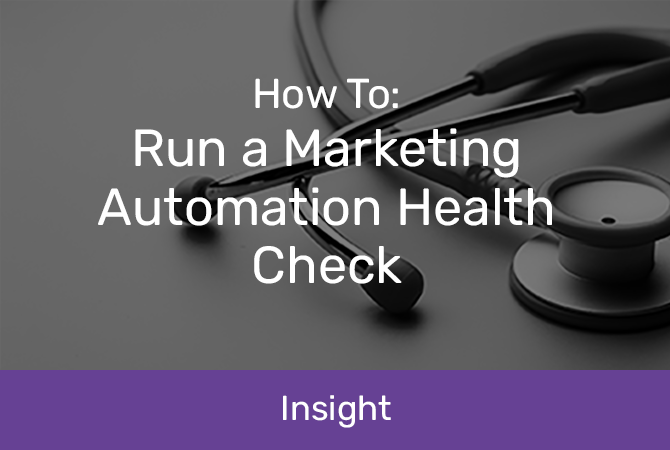
How To: Run a Marketing Automation Health Check
marketing automation not working? here's what to do
When you’re busy, it’s nice to imagine that marketing automation will let you wash your hands of that part of your job. Especially now platforms offer so many automation benefits using AI.
It’s why most marketers will only check their setup when something obvious breaks. Then, after they’ve tracked down the issue and fixed it, they go right back to ignoring it again.
But if you’re not regularly looking under the hood, you’ll end up with a system that’s not performing as well as it could or, sometimes, isn’t performing at all. The worst part is that you might not notice until the sales department starts yelling about lead numbers.
The simple solution? Plan to do regular marketing automation health checks. Here’s everything you need to know.
 what is a marketing automation health check?
what is a marketing automation health check?
You’ll have read a lot about marketing automation operation and measurement, but a health check goes one step further – it’s an essential part of properly managing your systems and processes.
Instead of just looking at the numbers, you’re trying to answer one fundamental question: “Is this automation really doing the job?”
 hOW TO RUN A MARKETING AUTOMATION HEALTH CHECK
hOW TO RUN A MARKETING AUTOMATION HEALTH CHECK
Your health checks should be about looking beyond the metrics to determine the real-world impact your marketing automation is having. If you’re using automation to streamline how you pass leads to your sales team, does it actually make things faster? Is your onboarding campaign delivering the outcomes you want? Is that cross-sell journey growing account revenue?
FOCUS ON THE RIGHT QUESTIONS
When digging around in your setup, it can be easy to get distracted by the detail, so keep focused on these four questions:
- Is it delivering the real-world benefits we need?
- Are the data flows and content personalisation still accurate?
- How could I optimise it?
- Is there a better way I could do this?
DO IT REGULARLY
How often should you be checking on your marketing automation? Like most things in life, the answer is, ‘it depends.’ If you’ve got business-critical automations or ones dealing with high user volumes, check them often – weekly or even daily, if necessary. For most setups, though, this health-check schedule is a good starting point:
- Week 1: Check daily
- Month 1: Check every week
- Year 1: Check every month
use the right analytics tool
It’s a good idea to consider the analytics tool you’re using. There are many out there, all offering different prices and functionalities – with spreadsheets at one end and complex, pricey platforms at the other. Figuring out if you’re using the right one is subjective. To help you decide, consider these questions:
- Can it easily track my chosen metrics?
- Will it display data in a way that makes sense to me?
- How well does it connect to, monitor, and alert on all my data sources?
- Is it easy for me to use?
- Is it within my budget?
Create a long list of platforms that tick all those boxes, get some demos and go with your gut.
REVIEW YOUR PROCESSES
You may have your data and tools running smoothly. but are your end-to-end processes enabling growth? Stand back and review:
- Who is involved?
- Are the processes opening you up to inconsistencies or risk?
- Are they efficient?
Any process that delivers revenue or risk should be reviewed to ensure that it is fit for purpose. Make sure that it's clear, timely, detailed enough to execute, but not overly cumbersome.
 stress test your data
stress test your data
Rubbish in, rubbish out – automation lives and dies on the quality of your data and how you manage it.
weed out the data skewers
Outside of the actual numbers and quality of the data you have, it's essential to consider things that could give misleading results. The most common causes are:
- Selection bias – are you looking at the whole picture or measuring only one part? For example, perhaps you’re measuring online conversions only, which are underperforming, and you’re missing the number of in-person sales driven by your automations.
- Outliers – creating averages is an easy way of understanding shifts in outcomes. Still, if one data point is unusually high or low, it can give you an inaccurate picture of what's happening. Say you need your automation to improve revenue per lead – if one contract is massively more valuable than the others, it’s best to exclude it.
- Confounding variables – these are variables you haven’t factored for, which can skew your results. Maybe you're patting yourself on the back for how many EVs your automated marketing campaign sold when the huge government incentive scheme also played a big part.
 analyse audience segmentation
analyse audience segmentation
If you’re trying to figure out why your marketing automation isn’t returning what you think it should, look at how you’re chopping up your audience. Your campaign and flow could be the gold standard, but if it’s chasing the wrong people or diluting your audience with poor likelihood customers, it simply won’t deliver. While you’ll be slicing and dicing your audience according to your business offering and objectives, those categories will be a mix of demographic, geographic and psychographic attributes.
demographics vs psychographics
Demographics (age, gender, income) and geographics (where they live) give hard data that are easy to gather and work with – but it’s not all that insightful. One 45-year-old woman living in Sydney may have different motivators from another woman with the same demographic markers.
The psychographic categories – behaviours, engagement, loyalty, preferences and motivations, for example – are far harder to measure but immensely more valuable. Demographics and geographics let you focus on people who are only like those you know will buy. Psychographics enable you to target precisely the people you know will buy.
find your focus
Look at how you categorise your audience – do you need a narrower age bracket? Should you focus only on customers who’ve purchased XYZ in the last two months? Are you targeting people in the correct city? Is your targeting too broad and diluting the impact? Great analytics software will help you here – you might see a spike or drop amongst a particular group. Can you figure out why?
 core metrics to get you started
core metrics to get you started
If you’ve done it right, your metrics will be specific to your campaign goals and audience, but you’ll find they fall within one or more categories.
1. engagement and BEHAVIOUR
Impressions or website traffic can tell you the campaign is doing something, but engagement metrics show that you’re doing something right – probably moving people down the sales funnel.
Engagement metrics track people’s behaviour or response to your campaign. This could be the number of pages people view on your site, the time they spend there, the number of comments, shares and likes on a social post, and clicks and unsubscribes from your email or social pages.
It’s a good idea to compare reach to engagement – if thousands of people are seeing your ad or email, but no one is clicking on it, it’s an indication that something is up with your targeting or creative.
2. conversion rate
Conversions are the ultimate measure of success. The key is to define what ‘conversion’ looks like – is it clicks into the site? Downloading a guide? Buying a product? Signing up to a service? A low-value ‘conversion’ can be easy to achieve but won’t deliver the numbers you want. That’s why you need to temper it with ROI metrics.
3. ROI
It’s easy to think that ROI is the be-all and end-all of measurement, but it doesn’t do much if the point of your campaign is to generate something less tangible than money – like brand awareness or sentiment.
4. QUALITY OF LEAD
Efficiency looks not at how many leads you brought in but whether they were good ones. Are the leads from people who’ll benefit from the product or service and can afford to buy it? Combine these numbers with conversion rates, and you'll know whether you’re attracting and nurturing the leads effectively and targeting the right people in the first place.
5. ACTIVITY METRICS
Automation is great until it stops working. It’s too easy to set and forget, get on with your day and not realise your Facebook Ads or email sends stopped three weeks ago. Check things like impression numbers, emails sent or bounce rates just to make sure there are no blocks in the pipe.
6. REVENUE GROWTH
While ROI measures revenue that can be directly attributed to your campaigns, looking at revenue growth is great if you expect your campaign to uplift sales less instantly. Perhaps your content marketing campaign is less about direct sales and more about increasing brand sentiment. Because so many things other than your marketing automation can affect revenue, adjusting for other influencing factors and measuring as big a period as possible is essential.
TRACK, MEASURE, TWEAK & REPEAT
Marketing automation shouldn't be a set-and-forget affair. Especially with platforms launching more and more capability and enhancements every quarter. Scheduling in regular marketing automation health checks means you can keep testing, learning and changing to ensure it’s doing the job.
Focus on why you set the automations up in the first place, consider if you’re using the right analytics tool, then put your data through the wringer – check sources and anything that might be skewing the results. Next, take a good hard look at your audience segmentation. This is tricky: it can be hard to get past your assumptions around audience segments and ensure you're targeting the right people.
And, if you still need to figure out how to rummage around in your marketing automation systems, get some help from the pros. That's where Datamine comes in – get in touch today.
At Datamine, we work with clients across Australia and New Zealand in almost every sector – from retail and banking to not-for-profits.















































